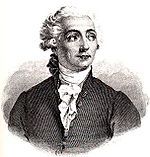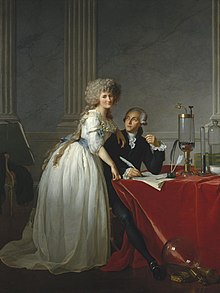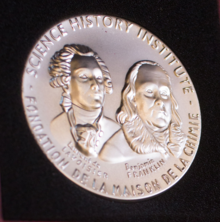Antoine Lavoisier
Antoine-Laurent de Lavoisier (Paris, August 26, 1743 - Paris, May 8, 1794) was a French chemist, biologist and economist who is considered the "father of chemistry". for his studies on the oxidation of bodies, the phenomenon of animal respiration, the analysis of air, the law of conservation of mass or Lomonosov-Lavoisier law, the caloric theory, combustion and his studies on the photosynthesis.
Biography
He was one of the main protagonists of the scientific revolution. He led to the consolidation of chemistry as a science, for which he is considered the founder of modern chemistry. His father was a lawyer in Villers-Cotterêts and in 1741 replaced one of his uncles in the position of attorney of the French Parliament (a court of last instance, it is not a legislative body), so he moved to Paris, where he married. His mother, Emilie Punctis, came from a family of lawyers and died when Lavoisier was only 5. In 1754 he began his studies at the College of the Four Nations, where he studied for nine years. Afterwards, he studied law at the University of Paris at the request of his father and obtained his bachelor's degree in 1764. But, as he liked science, he continued with free courses in botany with Bernard de Jussieu, in physics with the abbot Nollet, chemistry with Laplanche and Guillaume François Rouelle, and mineralogy with Jean Étienne Guettard.
In 1764, at the age of twenty-one, he presented a project to illuminate Paris that received an award for best study. In 1765, Lavoisier wrote two reports on gypsum, a mineral used in Paris to whiten houses and observed that the only difference between crystallized gypsum and powdered gypsum was the water of hydration and that one could simply be transformed into the other. gaining or losing water. In 1767, he traveled with Guettard to the Vosges to draw a geological and mineralogical map of the area, a five-month job.
In 1771, at the age of 28, Lavoisier married Marie-Anne Pierrette Paulze, daughter of a co-owner of the Ferme générale, the government concession for the collection of taxes in which Lavoisier participated. The dowry enabled him to set up a well-equipped laboratory where he was assisted by his wife, who took a genuine interest in science and took laboratory notes as well as translated writings from English, such as Essay on Phlogiston by Richard Kirwan and also the investigation of Joseph Priestley.
He often corresponded with various members of the Lunar Society group.
He was elected to the Academy of Sciences in 1768. He held various public offices, including state director of gunpowder works in 1776, member of a commission to establish a uniform system of weights in 1789 (predecessor of the General Conference of Weights and Measures) and commissioner of the treasury of 1791. Lavoisier tried to introduce reforms in the French monetary and tax system and in the methods of agricultural production.
In Lavoisier's investigations included some of the first chemical stoichiometry experiments. Where the reactants and products of a chemical reaction were carefully weighed in a sealed glass container, it was crucial in the advancement of chemistry. He showed that in a reaction, the amount of matter is always the same at the end and at the beginning of the reaction. reaction. These experiments provided evidence for the law of conservation of matter. Lavoisier also investigated the composition of water and named its components oxygen and hydrogen.
One of Lavoisier's most important experiments was to examine the nature of combustion, showing that it is a process in which a substance is combined with oxygen, refuting the phlogiston theory. He also revealed the role of oxygen in the respiration of animals and plants.
In the Elementary Treatise on Chemistry (1789), Lavoisier clarified the concept of an element as a simple substance that cannot be divided by any known method of chemical analysis, and elaborated a theory of the formation of compounds from the elements. He also wrote Memoir on Combustion (1777) and General Considerations on the Nature of Acids (1778).
Among Lavoisier's many discoveries, the ones that had the most impact were his studies of plant processes that were related to gas exchanges when animals respired (1783). Working with the mathematician Pierre Simon Laplace, Lavoisier enclosed a guinea pig for about 10 hours in a bell jar containing oxygen and measured the carbon dioxide produced. He also measured the amount of oxygen consumed by a man in activity and rest. With these experiments he was able to show that the combustion of carbon compounds with oxygen is the real source of animal heat and that oxygen consumption increases during physical work.
Lavoisier, along with L. B. Guyton de Morveau, Claude Louis Berthollet, and Antoine-François de Fourcroy, presented a new nomenclature to the Academy in 1787, because there was virtually no rational chemical nomenclature system at the time. The new system was inextricably tied to Lavoisier's new oxygen theory of chemistry. The 4 elements of earth, air, fire, and water were discarded, and instead accepted 55 substances that cannot be broken down into simpler substances by any chemical means, provisionally known as chemical elements.
In 1789 Lavoisier carried out quantitative studies on alcoholic fermentation and found, in addition to ethanol and carbon dioxide, another product to which he gave the name acetic acid. He found stoichiometrically with the aid of balances that 95.6 parts of sugar give 57.5% ethanol, 33.3% carbon dioxide and 2% acetic acid.
He worked in the collection of taxes, which is why he was arrested in 1793. Important figures did everything possible to save him. When all the work that Lavoisier had done was exposed to the court, it is said that the president of the court then pronounced the famous phrase: "The republic does not need scientists or chemists, the action of justice cannot be stopped." Lavoisier was guillotined on May 8, 1794, when he was 50 years old. Lagrange said the next day: "An instant was enough to cut off his head, but perhaps not in a century will there appear another that can compare to it."
A year after Lavoisier's death, he was exonerated by the new French government in a note addressed to his wife that read: "To the widow of Lavoisier, who was falsely convicted."
Legacy
Lavoisier's fundamental contributions to chemistry were the result of a conscious effort to fit all experiments within the framework of a single theory. He established the consistent use of the chemical balance, used oxygen to overthrow the phlogiston theory, and developed a new system of chemical nomenclature that held oxygen to be an essential constituent of all acids (which later turned out to be wrong).
Lavoisier also did early research in physical chemistry and thermodynamics in joint experiments with Laplace. They used a calorimeter to estimate the heat released per unit of carbon dioxide produced, eventually finding the same relationship for a llama and animals, indicating that the animals produced energy through a type of combustion reaction.
Lavoisier also contributed to early ideas about composition and chemical changes by enunciating the theory of radicals, according to which radicals, functioning as a single group in a chemical process, combine with oxygen in reactions. He also introduced the possibility of allotropy in the chemical elements when he discovered that diamond is a crystalline form of carbon.
He was also responsible for the construction of the gasometer, an expensive instrument that he used in his demonstrations. Although he used his gasometer exclusively for these, he also created smaller, cheaper, and more practical gasometers that worked with a degree of precision enough that more chemists could recreate them.
Taken together, their contributions are considered the most important in advancing chemistry to the level reached in physics and mathematics during the 18th century.
Mount Lavoisier, in the Paparoa Chain range of New Zealand, was named in his honor in 1970 by the Department of Scientific and Industrial Research.
Awards and Honors
In life, Lavoisier received a gold medal from the King of France for his work on urban public lighting (1766), and was made a member of the French Academy of Sciences (1768). He was elected a member of the American Philosophical Society in 1775.
Lavoisier's work was recognized as an International Historic Chemical Landmark by the American Chemical Society, the Académie des sciences de L'institut de France and the Société Chimique de France in 1999. The publication of Antoine Laurent Lavoisier de Louis 1788 titled Méthode de Nomenclature Chimique, published with his colleagues Louis-Bernard Guyton de Morveau, Claude Louis Berthollet, and Antoine-François de Fourcroy, was awarded the Division's Citation for Chemical Breakthrough Award in History of Chemistry from the American Chemical Society, awarded at the Académie des Sciences (Paris) in 2015.
Several Lavoisiers Medals have been named and awarded in Lavoisier's honor, by organizations such as the Société Chimique de France, the International Society for Biological Calorimetry, and the DuPont company. He is also commemorated with the Franklin-Lavoisier Prize, which marks the friendship of Antoine-Laurent Lavoisier and Benjamin Franklin. The prize, which includes a medal, is awarded jointly by the Fondation de la Maison de la Chimie of Paris, France, and the Science History Institute of Philadelphia, Pennsylvania, United States.
Some posts
- Opuscules physiques et chimiques (1774).
- Considérations générales sur la nature des acides (1778).
- South the combustion in général (1779)
- Mémoire sur la chaleur (1783)
- Méthode de nomenclature chimique (1787).
- Traité élémentaire de chimie (1789).
Acknowledgments
- It is one of 72 scientists whose name is registered at the Eiffel Tower.
- The lunar crater Lavoisier bears this name in his memory.
- The asteroid (6826) Lavoisier also commemorates its name.
Contenido relacionado
Antigonus I Monophthalmos
Alfonso II of Aragon
Naval modeling




